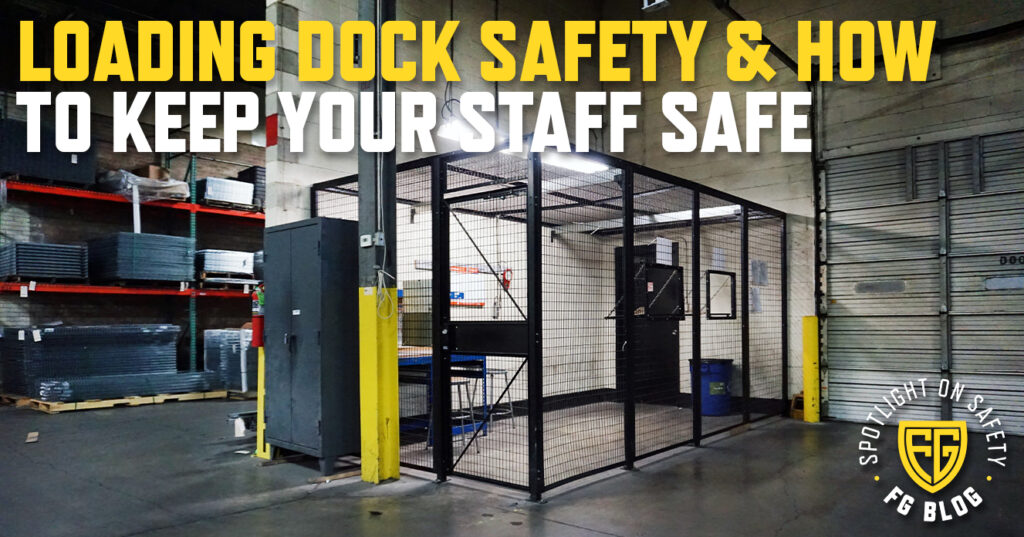Loading Dock Safety & How to Keep Your Staff Safe

The loading dock of any manufacturing plant or warehouse is often the busiest area in the building. All of that hustle and bustle can lead to potential safety and warehouse hazards, and it’s important to safeguard your facility and your employees against any such dangers. Here are just a few tips on how to keep your loading dock as safe as possible:
Dock Safety
This one seems like the most obvious, and as such, it’s the easiest to overlook. The physical dock itself and its typical 4 foot drop can present a serious hazard if not properly looked after. When a trailer has left the dock, a barrier needs to be immediately placed in front of the ledge to prevent anyone from falling.
ProGMA lists several types of barriers (some have arms that swing down, some are hinged gates, some are simple netting), but something must be placed in front of the ledge as soon as the trailer leaves the dock.
Ideally, especially in a particularly busy facility where trucks are in and out all day long, employers will install automatic barriers that will be triggered by the truck pulling out of the dock. This is helpful for two reasons: it avoids the possibility of forgetting to place the barrier (we’re all human!), and it is an elegant ergonomic solution. A loading dock is a physically demanding workplace, and the less strain that can be placed on workers, the better.
When thinking about dock safety, it is also important to consider the climate where your warehouse is located, and to protect your dock against it with a canopy or seal, to prevent slipping hazards caused by rain, snow, or ice.
Trailer Safety
Trailer safety goes hand in hand with dock safety. Safety and Health Magazine warns about “drive aways” and “trailer creeps”, two all-too-common trailer safety hazards that occur on loading docks.
A drive away happens when a driver pulls the trailer away from the dock while a forklift operator or worker is still loading the truck. A trailer creep occurs when the trailer inches slowly away from the dock, creating a gap into which people or equipment can fall. Both of these snafus are preventable.
The best defense against a drive away is a Driver Cage, like the ones we make here at Folding Guard. A Driver Cage is a fenced-in area accessible from the dock, but locked off from the rest of the floor, in which a driver can safely sit while the truck is being loaded or unloaded. To avoid a trailer creep, the truck can be restrained by wheel chocks or other vehicle restraints.
Traffic Safety
Traffic safety applies to the lot outside the dock as well as the many moving parts inside the facility. To safely direct traffic coming into the loading dock, consider using red and green lights (like traffic lights) to indicate to drivers when it is safe to pull into the dock.
Directing traffic inside the loading dock is just as important. It’s imperative to keep forklift operators and employees that are working on foot, safe and out of one another’s way. The best way to do this is by establishing known routes and rights of way using signage, floor indicators, and designated paths for specific traffic within the facility.
Forklift Safety
It’s important to be spatially aware of forklifts at all times on the loading dock and to give them a wide berth, but it’s also important to accommodate the dock to the forklifts. It can be difficult to gauge the distance from the edge of the forklift to the ledge of the dock, so be sure to create bright visual markers on the floor (in addition to the barriers) to indicate to the forklift drivers where to stop.
Safety By Design recommends on their website only driving a forklift onto a truck if it is flush against the dock; if there is any kind of gap or height discrepancy, the forklift could tip.
Warehouse Safety
Finally, in addition to creating foot traffic indicators inside the loading dock, ensure that any employee walking around is wearing PPE and reflective outerwear so that they can’t be missed by the forklift operators. Additionally, don’t allow any unauthorized personnel who don’t know the lay of the land or the safety guidelines to wander through the loading dock (another reason a Driver Cage is a must-have for any loading dock!).
By following these steps, you can ensure that your loading dock runs safely and efficiently. For more tips on how to keep your loading dock safe, check out ProGMA. For more information on Driver Cages, contact our team.
